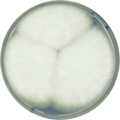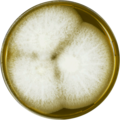| Aspergillus leporis | |
|---|---|
| Scientific classification | |
| Kingdom: | Fungi |
| Division: | Ascomycota |
| Class: | Eurotiomycetes |
| Order: | Eurotiales |
| Family: | Aspergillaceae |
| Genus: | Aspergillus |
| Species: | A. leporis |
| Binomial name | |
| Aspergillus leporis States & M. Christensen (1966) [1] | |
Aspergillus leporis is an anamorph species of fungus in the genus Aspergillus . [1] [2] [3] It is from the Flavi section. [4] The species was first described in 1979. [5] It has been isolated from the dung of Lepus townsendii. [6] Aspergillus leporis produces leporin A and leporin B. [3] [7] [8] It has also been reported to produce antibiotic Y, kojic acid, and pseurotin. [4]

